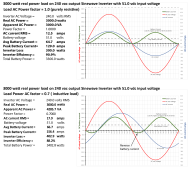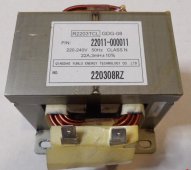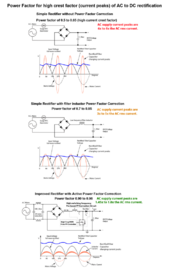While running off-grid for the better part of a year now, I've been monitoring energy use carefully. What I've overlooked, until now, is reactive power. I'm trying to wrap my head around it, but I think I've got the basic gist of it: capacitance or inductance as a load leads or lags the phase. What I don't fully understand is where that reactive power "goes".
Stored, similar to energy stored in a spring or in a moving mass. Then thrown back at the grid (or battery inverter). Cycles between drawing power and returning power. So long as your inverter can handle that, no huge problem. That is what a "4 quadrant" amplifier can do.
But I've seen some UPS which seemed to dissipate the power thrown back at them. It registered 350W load, but with load fed through a power transformer that jumped to 900W
My understanding is that it's dissipated as heat in both the appliance and the inverters.
Power factor < 1.0 increases loss, but not all the difference between "Apparent Power" and "Reactive Power" is lost as heat.
Voltage available is the same, so higher apparent power involves higher current. Power dissipated in wires, breakers, MOSFETS is due to I^2R and causes heating, so higher current causes more heating, proportional to square of current.
Further, I've come to believe/understand that SMA inverters have active Power Factor Correction, while Victron inverters do not.
I think it can only be enabled and set by command. GT PV inverter has no knowledge of power factor at grid (or battery inverter) connection so can't adjust in response.
The manual for my TriPower mentions "Q on Demand"
"Controlling the Q(V) Characteristic Curve with Integrated Plant Control
The Sunny Tripower inverter can provide reactive power to the utility grid with the "Integrated Plant Control" function. The grid operator specifies via which process the inverter is to provide reactive power to the utility grid. In many cases, the grid operator will request control in accordance with a Q(V) characteristic curve. SMA inverters with "Integrated Plant Control" are capable of reproducing this Q(V) characteristic curve without performing any measurement at the grid-connection point. The inverter can automatically compensate for equipment installed between the inverter and the grid-connection point.
The function "Integrated Plant Control" is not capable of compensating for irregular or fluctuating reactive power demands due to, for example, connected machinery, if the machinery is connected between the inverters and the gridconnection point. If the machinery is connected directly at the grid-connection point, it is possible to dynamically determine the additional reactive power demand of the machines using additional measurement equipment and then to provide this value as an offset to the Q(V) control."
Says some aspect can be automatically detected and compensated by those inverters, but for the most part you have to measure power factor and program the inverter.
While "Volt-Var" function of UL-1741-SA inverters may be this sort of PFC, TriPower can be told to keep operating at night of PV input goes to zero. It just acts as a programmable PFC device, therefore "Q on demand 24/7"
I'm now trying to ascertain just how much energy I'm losing, and whether or not it's even worth the concern.
I think it is only in GT PV inverters to benefit the utility. And to allow higher power delivery to grid. It seems to be part of UL-1741-SA or SB.
I've got multiple inverter-based compressor appliances in the house: window AC/heat pumps and a refrigerator. These have a poor power factor, but due to their variable speed, PFC can't be performed with simple capacitors or inductors, but needs to be done with active PFC circuitry, as far as I understand.
Different kind of < 1.0 PF
Inductors delay sine-wave current 90 degrees. Capacitors advance sine-wave current 90 degrees.
(Motors I've measured had a different, more complicated waveform.)
Cheap VFD have a rectifier/capacitor front end. If you simply fed rectifier into a resistive load, would still have in-phase sine-wave current and PF ` ~ 1.0 (diode adds voltage drop and non-linear resistance). But rectified into capacitor, there is zero current until line voltage exceeds capacitor voltage. Then a gulp of current, then no current when voltage again drops below capacitor voltage.
3rd plot top green trace is current drawn by VFD ("V" represents amps).
(Lower red trace is AC current sensor on battery cable.)
https://diysolarforum.com/threads/battery-ripple-current.22431/
The brief higher current into VFD causes more heating of wire and thermal breaker, because power loss and heating is proportional to square of current. If half the time, twice the current, then 4x the heating times 1/2 the time = 2x power dissipation. The breaker would be able to carry 0.71 times as much power before tripping. With 20A breaker, 2 HP pump eventually trips it at full speed. When 15A breaker fed induction motor, it never tripped.
What I'd like to ask: is all of the reactive power provided by the inverters lost to heat?
As described above, higher power factor of reactive load means higher current, which causes higher loss. But mostly, the power stored in "reactive" loads such as inductors and capacitors is returned to source as out of phase current.
This page describes how SMA inverters can correct a site's power factor to avoid charges from the utility. Since I'm off-grid, I'm mainly concerned about wasting energy and depleting batteries. I'm wondering if the Sunny Boy or Sunny Islands are actually doing active PFC, and if so, whether it's saving energy, or merely improving power quality. I've got a kill-a-watt that shows VA and PF, as well as a o-scope, but I'm not sure how to check or confirm. Sunny Boy instant values contain a reactive power measurement in the "AC Meter" section, if memory serves, but it's always blank, which I'm guessing is because I don't have an SMA meter installed.
GT PV inverters normally deliver current 180 degrees out of phase with voltage (compare to resistive load 0 degrees out of phase), so they deliver power rather than absorbing. The SMA inverters can be programmed to deliver leading or lagging current, simulating a capacitor or inductor in parallel. That could compensate for other loads in the facility, making power factor closer to 1.0. Primary benefit to owner would be reducing charges imposed by utility. It reduces current and therefore loss in utility power lines.
It should increase power available to facility through main breaker. Assuming GT PV inverter is on a separate branch circuit, it doesn't change PF and current in any facility wires so doesn't save power inside the facility.
With an alternative energy system, PFC would reduce current drawn from inverter, leaving more current to be drawn by loads. Inverters might be rated in "W", but really have a "VA" limit due to maximum current they can deliver. If some of the current is reactive power, that reduces available wattage. The inverter might have a separate actual wattage limit due to boost converter of HF design (also current limit of battery and/or PV.)
Hopefully
@Hedges and
@RCinFLA won't mind me tagging them to get their attention... Thanks in advance!
My Sunny Islands are able to power the VFD, also induction motor in AC (second picture, triangular current waveform for some reason.)
However, when the Sunny Boy GT PV inverters wake up and see the voltage waveform (I still need to capture that and view), they think they have an internal fault and don't connect to deliver power.
I tried paralleling an unloaded induction motor thinking it would provide PFC for the VFD, but current waveform at inverter unchanged.
For now I don't operate it offgrid. Plan is to add PFC modules in front of VFD (those draw sine wave current and deliver 360VDC).
Better quality VFD have PFC inside.
Besides VFD, typical power transformers draw non-sinusoidal current and have poor PF at least under light load.
Pictures in following link are transformer secondary backfed with line voltage, Primary fed at 1/2 rated line voltage, Primary fed at normal rated line voltage. Notice how current shoots up at peak, badly distorting sine wave. That is due to saturation, inductance drops off. Feeding primary works better than backfeeding secondary, and at half voltage it is much closer to an ideal transformer.
So you think you can backfeed a transformer secondary, either as step-up or as auto-transformer? Turns out these things aren't so ideal and reversible as one might expect. It isn't just the greater inrush (primary is often wound outside secondary to reduce inrush current), but also idle current...

diysolarforum.com






